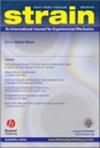大型钢-复合材料粘接接头在静载疲劳作用下的强度和变形试验与数值分析
IF 2.4
3区 材料科学
Q2 Engineering
引用次数: 0
摘要
摘要本文报道了全尺寸粘接钢-复合材料接头的疲劳行为和准静态强度的研究。在船厂条件下,用大约10毫米厚的甲基丙烯酸甲酯粘合剂层制造了三个接缝。其中一个试件进行了拉伸试验直至失效,两个试件进行了~ 350万次疲劳循环,然后进行了数字图像相关支持的残余拉伸试验。由于钢支架的不对称设计,粘接线内的剪切、纵向和剥离应变值在夹紧侧明显较高。所有试件的抗剪强度都明显高于造船商定义的设计值。光纤Bragg传感器监测钢和复合材料成分的应变,并允许检测拉伸测试样品的损伤发生和演变。在小型实验的基础上,建立了包含材料和界面特性的有限元模型。静载试验中应变的模拟结果与DIC测量结果吻合较好。由于复合材料面板的分层,所有试样在复合材料-粘合剂界面附近失效。本文章由计算机程序翻译,如有差异,请以英文原文为准。
Experimental and numerical analysis of strength and deformation of large‐scale steel‐composite adhesive joints subjected to fatigue followed by static loading
Abstract This work reports a study of the fatigue behaviour and quasi‐static strength of full‐scale adhesively bonded steel‐composite joints. Three joints with an approximately 10‐mm‐thick layer of methyl methacrylate adhesive were manufactured in dockyard conditions. One specimen was tensile tested till failure, while two specimens were subjected to ~3.5 million fatigue cycles, followed by a residual tensile test supported with digital image correlation. The shear, longitudinal and peel strain values within the adhesive bondlines are significantly higher at the gripped sides due to the asymmetrical design of the steel brackets. All specimens showed a significantly higher shear strength than the design values defined by the shipbuilder. Fibre Bragg sensors monitored strains at steel and composite constituents and allowed to detect damage onset and evolution in tensile tested specimens. A finite element model of the joint was developed with material and interface properties based on dedicated small‐scale experiments. The simulation results of strains during a static load test corresponded closely to the DIC measurements. All specimens failed near the composite‐adhesive interface due to delamination of the composite panel.
求助全文
通过发布文献求助,成功后即可免费获取论文全文。
去求助
来源期刊

Strain
MATERIALS SCIENCE, CHARACTERIZATION & TESTING-
CiteScore
4.50
自引率
4.80%
发文量
27
审稿时长
2.3 months
期刊介绍:
Strain is an international journal that contains contributions from leading-edge research on the measurement of the mechanical behaviour of structures and systems. Strain only accepts contributions with sufficient novelty in the design, implementation, and/or validation of experimental methodologies to characterize materials, structures, and systems; i.e. contributions that are limited to the application of established methodologies are outside of the scope of the journal. The journal includes papers from all engineering disciplines that deal with material behaviour and degradation under load, structural design and measurement techniques. Although the thrust of the journal is experimental, numerical simulations and validation are included in the coverage.
Strain welcomes papers that deal with novel work in the following areas:
experimental techniques
non-destructive evaluation techniques
numerical analysis, simulation and validation
residual stress measurement techniques
design of composite structures and components
impact behaviour of materials and structures
signal and image processing
transducer and sensor design
structural health monitoring
biomechanics
extreme environment
micro- and nano-scale testing method.
 求助内容:
求助内容: 应助结果提醒方式:
应助结果提醒方式:


